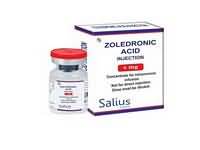CLINICAL USE
Hypercalcaemia of malignancy Reduction of bone damage in advanced malignancies Paget’s disease
DOSE IN NORMAL RENAL FUNCTION
Hypercalcaemia of malignancy: 4 mg as a single dose Reduction of bone damage in advanced malignancies: 4 mg every 3–4 weeks Paget’s disease: 5 mg as a single dose
PHARMACOKINETICS
DOSE IN RENAL IMPAIRMENT
GFR (mL/MIN)
>60 Dose as in normal renal function 50–60 3.5 mg 40–49 3.3 mg 30–39 3 mg <29 Use 3 mg with caution if benefit outweighs risk
DOSE IN PATIENTS UNDERGOING RENAL REPLACEMENT THERAPIES
IMPORTANT DRUG INTERACTIONS
Potentially hazardous interactions with other drugs Other nephrotoxic drugs: use with caution as can enhance nephrotoxicity
ADMINISTRATION
Reconstition
Add 5 mL of water for injection to each 4 mg vial
Route
IV
Rate of Administration
15 minutes
Comments
Add to 100 mL sodium chloride 0.9% or glucose 5% Reconstituted solutions are stable for 24 hours at room temperature
OTHER INFORMATION
Also administer a calcium supplement of 500 mg daily plus 400 IU of vitamin D daily Increased risk of renal deterioration if GFR <10 mL/min – measure creatinine while on zoledronic acid Increased risk of renal impairment in older patients, smokers, previous pamidronate therapy and renal failure. (Oh WK, Proctor K, Nakabayashi M. The risk of renal impairment in hormone-refractory prostate cancer patients with bone metastases treated with zoledronic acid. Cancer. 2007, Mar 15; 109(6): 1090–6.) Incidence of acute renal failure is 10.7%, usually due to acute tubular necrosis. (Chang JT, Green L, Beitz J. Renal failure with the use of zoledronic acid. N Engl J Med. 2003; 349(17): 1679–9.) Increased risk of renal failure if use 8 mg May cause osteonecrosis of the jaw .
